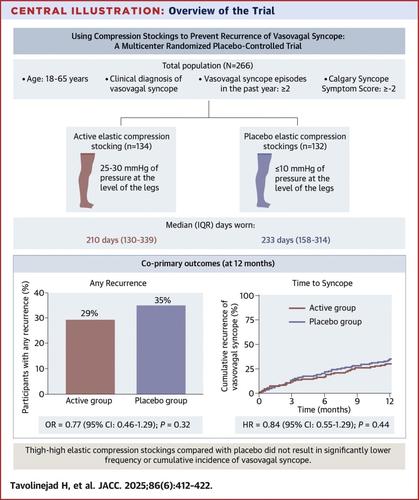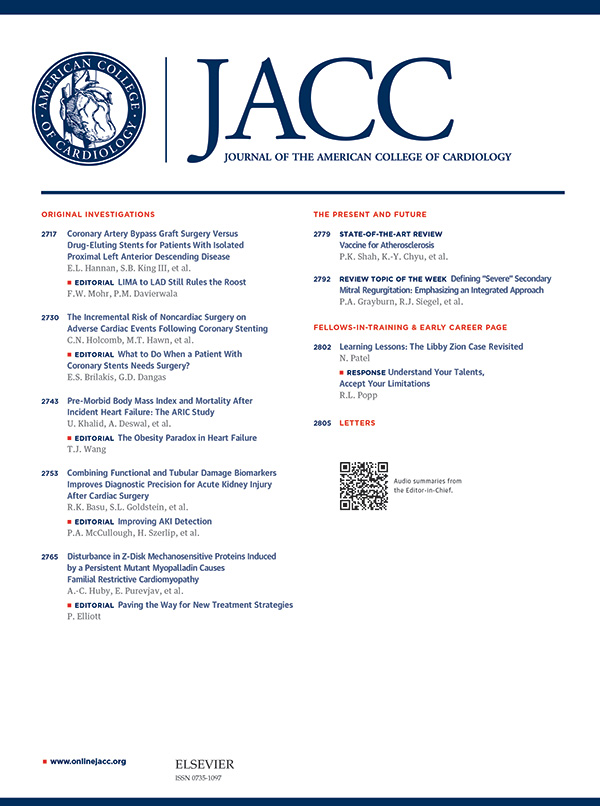Using Compression Stockings to Prevent Recurrence of Vasovagal Syncope
IF 22.3
1区 医学
Q1 CARDIAC & CARDIOVASCULAR SYSTEMS
引用次数: 0
Abstract
Background
Vasovagal syncope (VVS) is a common yet challenging condition with limited effective treatments. Elastic compression stockings (ECS) have been proposed as a potential therapy, but their real-world effectiveness remains unclear.
Objectives
This study sought to compare the effectiveness of lower extremity compression with thigh-high ECS vs sham stockings for the prevention of VVS recurrence.
Methods
This multicenter, parallel, blinded, randomized sham-controlled trial enrolled adults 18 to 65 years of age with ≥2 VVS episodes in the past year. Participants were randomized 1:1 to receive either thigh-length, open-toe active ECS (25-30 mm Hg pressure to the leg), or identical-looking sham ECS (≤10 mm Hg pressure). All participants received standard care (education and lifestyle modifications) but no medications for preventing VVS recurrence. ECS adherence was tracked using diary booklets. The coprimary outcomes were: 1) the proportion of participants with ≥1 VVS recurrence; and 2) the time to first VVS recurrence (ie, VVS-free survival).
Results
Among 266 participants (mean age 39 years, 58% female), during 12 months of follow-up, VVS recurred in 29.1% (n = 39 of 134) of participants in the treatment group and 34.8% (n = 46 of 132) in the control group (absolute risk reduction: 5.7%; P = 0.315). VVS-free survival was not significantly different (HR: 0.81; 95% CI: 0.53-1.24; P = 0.333). ECS adherence was suboptimal, with discontinuation rates of 37.3% in the treatment arm vs 34.8% in the sham arm. Discontinuation rates, duration of using ECS, and adherence rates were similar between treatment groups. The median number of recurrent episodes was similar (treatment: 2.5 vs sham: 2; P = 0.839). However, significantly fewer VVS episodes occurred while actively wearing ECS (32.7% vs 45.1%; P = 0.024).
Conclusions
Treating syncope with thigh-high lower limb compression using ECS did not reduce the cumulative incidence of VVS recurrence, and did not change VVS-free survival. Additionally, ECS did not reduce the frequency of multiple VVS episodes. The results do not support routine use of thigh-length ECS, although it may be helpful for selected patients when added to standard care. Because our study specifically tested thigh-high ECS, future studies should aim to assess the effectiveness of more extensive compression targeting pelvic and abdominal venous pooling.

加压长袜预防血管迷走神经性晕厥复发
迷走神经性晕厥(VVS)是一种常见但具有挑战性的疾病,有效治疗方法有限。弹性压缩袜(ECS)被认为是一种潜在的治疗方法,但其实际效果尚不清楚。目的:本研究旨在比较下肢压迫与大腿高ECS与假丝袜预防静脉血栓复发的有效性。方法:该多中心、平行、盲法、随机的假对照试验招募了18 ~ 65岁的成年人,在过去一年中有≥2次VVS发作。参与者以1:1的比例随机分配,接受大腿长度、露趾的主动ECS(腿部压力为25-30毫米汞柱),或相同的假ECS(压力≤10毫米汞柱)。所有的参与者都接受了标准的治疗(教育和生活方式的改变),但没有预防VVS复发的药物。使用日记簿跟踪ECS依从性。主要结局为:1)VVS复发≥1次的受试者比例;2)第一次VVS复发的时间(即无VVS生存期)。结果266名参与者(平均年龄39岁,女性58%)在12个月的随访中,治疗组中有29.1%(134人中有39人)复发VVS,对照组中有34.8%(132人中有46人)复发VVS(绝对风险降低:5.7%;P = 0.315)。无vvs生存期差异无统计学意义(HR: 0.81;95% ci: 0.53-1.24;P = 0.333)。ECS依从性不理想,治疗组停药率为37.3%,而假手术组停药率为34.8%。治疗组间的停药率、使用ECS的持续时间和依从率相似。复发发作的中位数相似(治疗组:2.5次vs假手术:2次;P = 0.839)。然而,积极佩戴ECS时VVS发作明显减少(32.7% vs 45.1%;P = 0.024)。结论ECS治疗晕厥伴下肢高位压迫不能降低VVS复发的累积发生率,也不能改变无VVS的生存期。此外,ECS并没有减少多次VVS发作的频率。结果不支持常规使用大腿长度的ECS,尽管当加入标准治疗时,它可能对选定的患者有帮助。由于我们的研究专门测试了大腿高度的ECS,未来的研究应该旨在评估更广泛的针对骨盆和腹部静脉池的压迫的有效性。
本文章由计算机程序翻译,如有差异,请以英文原文为准。
求助全文
约1分钟内获得全文
求助全文
来源期刊
CiteScore
42.70
自引率
3.30%
发文量
5097
审稿时长
2-4 weeks
期刊介绍:
The Journal of the American College of Cardiology (JACC) publishes peer-reviewed articles highlighting all aspects of cardiovascular disease, including original clinical studies, experimental investigations with clear clinical relevance, state-of-the-art papers and viewpoints.
Content Profile:
-Original Investigations
-JACC State-of-the-Art Reviews
-JACC Review Topics of the Week
-Guidelines & Clinical Documents
-JACC Guideline Comparisons
-JACC Scientific Expert Panels
-Cardiovascular Medicine & Society
-Editorial Comments (accompanying every Original Investigation)
-Research Letters
-Fellows-in-Training/Early Career Professional Pages
-Editor’s Pages from the Editor-in-Chief or other invited thought leaders

 求助内容:
求助内容: 应助结果提醒方式:
应助结果提醒方式:


